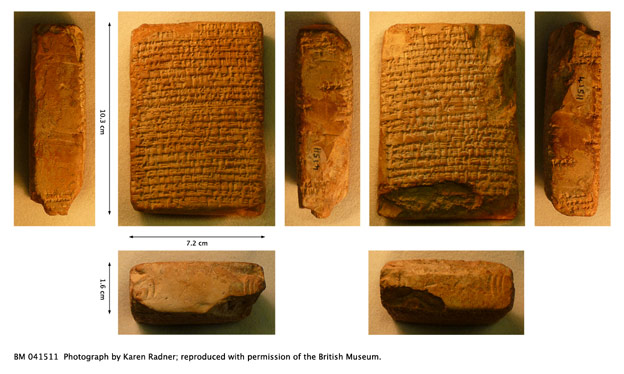BM 041511: sale contract for date orchard, from Babylon

BM 041511: sale contract for date orchard, from Babylon (Egibi archive), reign of Nabonidus (Neo-Babyonian period, 556 BC). Photograph by Karen Radner; reproduced with permission of the British Museum. View large image.
The tablet is part of the business archives of the Egibi PGP family of Babylon PGP , covering a period of more than a century and five generations. It is the largest private archive known from first-millennium Babylonia: 1700 texts dating to 606-482 BC survive of an estimated original 2500-3000 tablets. At the end of the 7th century BC a unified state, the Neo-Babylonian Empire, had emerged after centuries of political fragmentation and foreign rule. The last three generations of the Egibi family were among the richest inhabitants of Babylonia, profiting from and capitalising on their ancestors' shrewd exploitation of the new business opportunities resulting from the transformation of Babylonian society.
This land sale contract belongs to the business records of Nabu-ahhe-iddin, the head of the second generation of Egibis, who was pivotal in his family's rise to prominence and wealth. Here, he is buying up date orchards in the surroundings of Babylon. The tablet's brick shape is typical for this type of legal document. It bears the impressions of two cylinder seals on its left and right edges, and the short labels accompanying these impressions identify them as the seals of the two notary scribes who validated the sale. The vendor of the date orchards also needed to seal the contract but, as is explained in the final two lines of the text on the reverse, he used his fingernail to seal the contract. Four sets of his nail impressions, in groups of three, decorate the lower and upper edge of the tablet. The use of fingernails instead of seals is a very common feature of first-millennium legal documents, both in Babylonia and Assyria.
The British Museum also houses a contemporaneous copy of this contract (BM 32192) which, apart from the missing fingernail and seal impressions, is an exact duplicate of our text.
A transliteration and German translation of the contract can be found in Wunsch, Das Egibi-Archiv I (2000), no. 48 and also online on Achemenet [http://www.achemenet.com/pdf/wunsch/wunschall048.pdf] [161 kB PDF file].
Content last modified on 05 Dec 2016.
Karen Radner
Karen Radner, 'BM 041511: sale contract for date orchard, from Babylon', Knowledge and Power, Higher Education Academy, 2016 [http://oracc.museum.upenn.edu/saao/knpp/cuneiformrevealed/tabletgallery/bm041511/]